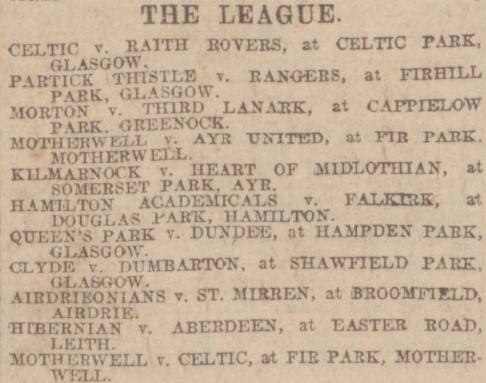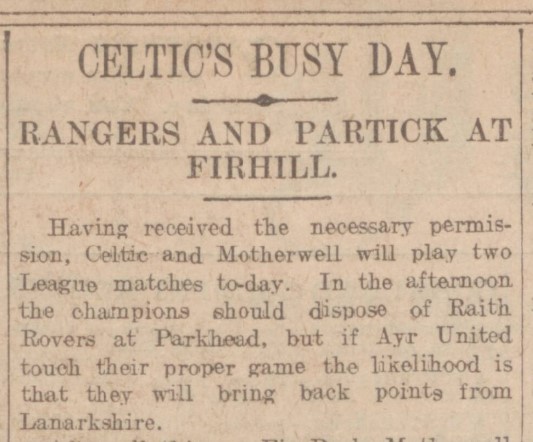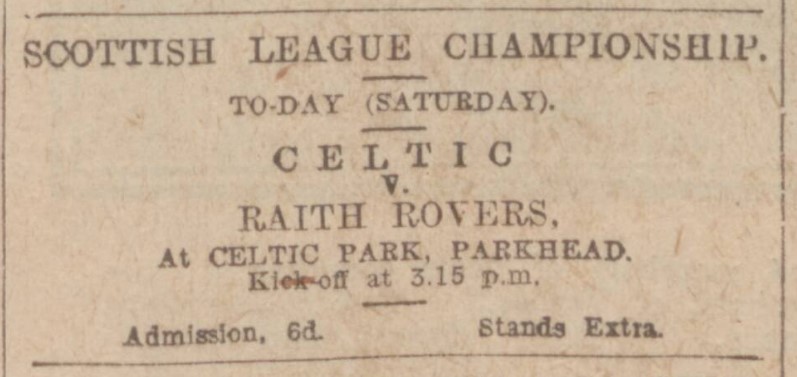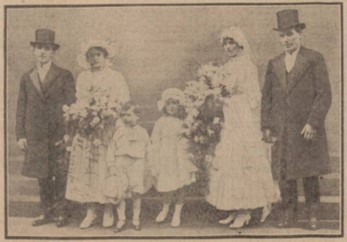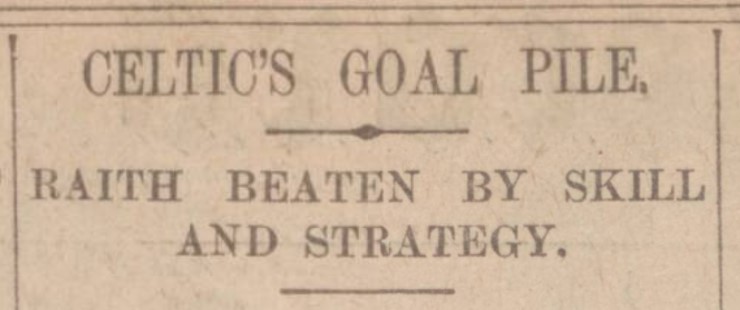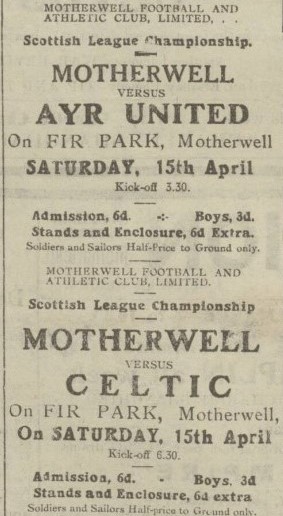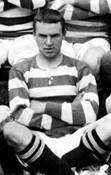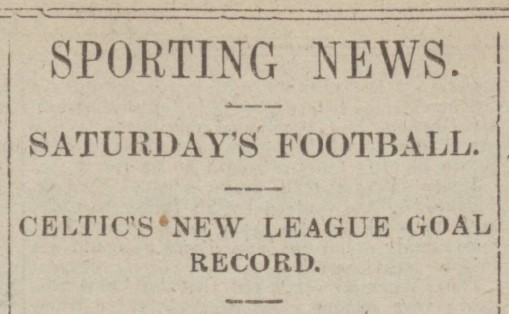Anyone looking at the Scottish League fixtures published for Saturday 15th April 1916 would have been forgiven for thinking a typo had been made. Instead of ten fixtures there were eleven – and it looked as though Celtic and Motherwell were listed to play twice.
Reading the match reports in the evening papers later that day, it became apparent there was no error. Not only had Celtic played two first-team games in three hours at two different locations – they had also won the league title for good measure!
Willie Maley’s Celtic team were chasing a third title in succession in season 1915-16. After an indifferent start, the Bhoys had raced into a lead that they rarely looked like relinquishing. However, the abandonment of an away fixture against Motherwell on 25th March 1916 due to heavy snow, presented a difficultly.
The First World War was underway and strict wartime regulations restricted the days on which games could be played and a Scottish League rule required all fixtures to be concluded by 30th April. Fixture congestion was so bad this season however that authorisation had to be given for midweek fixtures. There was no available date for Celtic to play the outstanding game.
To solve the conundrum of accommodating the Fir Park tie amidst the congestion, Celtic came up with a novel and, to some, bizarre idea: playing two first-team games on the same day.
On 15th April, Celtic were scheduled to play Raith Rovers at home in Glasgow. The Celtic directors suggested the team could travel to Motherwell after that game to play the outstanding fixture. Motherwell’s directors, keen not to lose out on the gate receipt bounty that a visit from the Celtic support meant, were in agreement. However, Ayr United were due to play at Fir Park at the same time Celtic were kicking off against Raith Rovers. The Ayrshire outfit protested that the proposed arrangement ‘would mean financial loss to them’ as fewer spectators would turn out for their game if the reigning champions were coming to visit little over an hour later.
It was Celtic manager Willie Maley, who came up with a solution. Celtic offered to pay £10 to top-up Ayr’s share of their Fir Park gate receipts to offset the cost of any drop in attendance. That financial guarantee was sufficient to secure the agreement of the Ayr United board and the Scottish League gave their approval to this unique football double-header.
So it came to pass that on 15th April 1916 that Celtic kicked off against Raith Rovers at 3.30pm, then travelled to Motherwell to play again at 6.30pm. If Celtic were to win both games and Rangers failed to beat Partick Thistle at Firhill on the same day, the Bhoys would be declared Champions.
To make matters even more interesting, Celtic were also chasing a Scottish League goal-scoring record. In season 1907-8, Falkirk had amassed an incredible 103 goals in Division One. Going into these two games, Celtic were sitting on 98 goals. With two bites at the cherry, could Maley’s team win the title and set a new goals record on the same day?
The Celtic team that lined up against Raith Rovers was Shaw; McNair and McGregor; Young, Dodds and McMaster; McAtee and Gallacher; O’Kane; McMenemy and Browning. It was a full-strength line up with the exception of defender Peter Johnstone and striker Jimmy McColl who were both carrying injuries.
Jimmy McMenemy later revealed that Maley had given the team a pre-match pep talk: ‘It was the one about the dog with two bones, and they were advised not to lose sight of the first match, because of the second. “You can get the necessary number of goals if you go the right way about it,” were the words he used.’ Go about it, they did.
Ten thousand supporters watched on at Celtic Park, as Joe O’Kane, the 18-year-old reserve striker who had replaced the injured McColl, opened the scoring in 15 minutes. O’Kane then grabbed a second ten minutes later with a shot from a tight angle. Celtic went in at half-time 3-0 ahead after Patsy Gallacher ‘clinched’ a cross from Browning. The Scotsman noted the home team’s superiority, saying that Raith had ‘failed miserably’ and that Celtic goalie, Charlie Shaw, had been ‘practically a spectator all the time.’
Joe O’Kane
When Celtic returned to the field and the second half got underway, Grampian in his match report for the Daily Record and Mail noted that ‘It was evident from the way that Celts resumed that they meant that goal record.’ Celtic were sitting on 101 goals, two short of the target – which Patsy Gallacher had his sights set on. Grampian wrote: ‘Gallagher had to retire to the touch-line for attention by the trainer, but on returning soon made it apparent that his repairs had been thoroughly carried out. He put the finishing touch to a hot Celtic attack.’ It was now 4-0 and 102 goals.
Peerless Patsy
Five minutes later, Patsy went on one of his famous mazy, meandering runs through the Rovers defence which he finished brilliantly, bringing Celtic level with Falkirk’s record and grabbing himself a hat-trick. As the game entered its last ten minutes, those ten thousand voices roared the Celts on to try and set a new record by snatching one more goal.
Grampian recorded what happened next: ‘Seven minutes from time a regular bombardment of the Rovers’ goal ended in Dodds scoring with a terrific drive.’ Joe Dodds, Celtic’s popular centre-half, had struck a 40-yard shot which ‘sailed under the bar’ – causing him to jump with glee!
He was not the only one in delirious celebration according to the Glasgow Observer: ‘It is beyond me to describe the scene when Joe got the ball home. The crowd simply went mad and, but for the iron railing, I fear the players would have had trouble getting off the field and into their clothes for the joy ride to Motherwell.’
Joe Dodds (on the right) enjoyed another momentous day a few weeks later on 8th June 1916 when he got married at St Aloysius Church, Glasgow. Team-mate Jimmy McMenemy (on the left) was his groomsman.
Of course, despite winning 6-0 and creating a new record, the Celtic team had little time to celebrate. It was now after 5pm and they still had to make their way to Motherwell for the 6.30 kick-off in their second game of the day. There was no time for the players to get changed out of their playing kit either as ‘a dizzy motor run’ transported the Celtic party to Fir Park. The Celtic support also had to leave the ground quickly and make their way by either brake or train to Motherwell in time for the next match.
On arrival in North Lanarkshire, there was good news waiting both players and fans -Partick Thistle had battered Rangers into submission 5-2 at Firhill. Celtic were now ten points ahead of the Ibrox men, who had only five games left to play. A draw or victory over Motherwell would hand the championship to Celtic.
Over 8,000 fans were in attendance at Fir Park when this Celtic team strode out at 6.30pm: Shaw; McNair and McGregor; Young, Dodds and McMaster; McAtee and Gallacher; Cassidy; McMenemy and Browning. 22-year-old ‘Trooper Joe’ Cassidy at centre-forward was the only change made by Maley, in favour of the youthful Joe O’Kane who had put in a fine shift in the earlier game.
Motherwell made three changes from the team that had been beaten 3-1 by Ayr United that afternoon. There were two names in claret and amber that have become synonymous with Celtic. Playing on the right wing was Frank Kelly, eldest son of Celtic’s first captain and former club chairman, James Kelly, while in defence was Frank McStay – whose younger brothers Willie and Jimmy would later go on to captain the Celts.
In the Daily Record and Mail, Clydebridge captured the kick-off setting well: ‘Motherwell’s game with Celtic commenced amid the slanting rays of the setting sun and concluded under the pale moonlight.’ The game got off to a rip-roaring start according to The Scotsman: ‘The play was wonderfully fast and at times was even exciting.’ Clydebridge was pleasantly surprised at how both teams went about playing their second game of the day:
I had expected to see flat, stale and unprofitable football from men who had barely had time for a breather after their previous exertions, but in this I was agreeably surprised, for the magnetic presence of the Celtic seemed to put life and metal in the heels of the Motherwell men.
Clydebridge also referred to Celtic’s Fir Park bogey: the Celts had not won in Motherwell in seven long years. The Bhoys went at it with ‘an initial rush that there was no holding back.’ First, Jimmy McMenemy headed home from a corner and soon after, Celtic were awarded a penalty when Joe Cassidy was impeded while bearing down on the Motherwell goal. Up stepped Joe Dodds to convert it, scoring his second of the day and giving Celtic a 2-0 lead at half-time.
As it was after 7pm and the light was failing – floodlights were not officially sanctioned until the 1950s. The teams ‘about-turned without leaving the field.’ The chatter on the Celtic terracing focused on two main issues: could the Fir Park bogey be laid at last and could the title secured? It was looking good on both counts.
Although clearly tired, both sides returned to the fray with conviction, with Celtic launching repeated attacks. The Motherwell Times reported that ‘The artistic footwork of M’Menemy and Gallagher kept the crowd in good humour.’ The second half hadn’t long started when great combination work between Cassidy and Johnny Browning saw the latter score to put Celtic into an unassailable lead. Just as the game ‘was being finished in semi-darkness’, the Fir Park team scored a consolation goal, making the final result 3-1 to Celtic.
Johnny Browning
At the end of this remarkable day, Celtic had won two matches, set a new goals record, won at Fir Park for the first time in seven years and won the Scottish League for the third year in succession! Willie Maley’s suggestion of adding £10 to Ayr United’s guarantee had proven a masterstroke.
CHAMPIONS SURE was the headline in Monday’s Daily Record and Mail. Brigadier wrote underneath: ‘If anybody had any hankering or idea that an earthquake or a miracle might occur and Celtic lose their hold of top place on the League table, the match with Motherwell dispelled it. Whatever may happen to Celtic now, they cannot be dethroned.’ The Scottish League had been in operation for 26 years and Celtic had won the championship for a 13th time. Celtic historian Dr James Handley noted that the club were ‘retaining as many flags at Parkhead as were held by all the other Scottish clubs combined.’
Celtic would go on to score 116 league goals in total that season, smashing the old record to pieces, and finished nine points above second-placed Rangers. This Celtic team had re-written Scottish football history but events elsewhere quickly overshadowed their achievements.
The Monday after the double-header, an uprising began in Dublin that would ultimately lead to the creation of an Irish Free State. The ‘Great War’ being fought between imperial powers in the fields of France turned into a horrifying slaughter of hundreds of thousands. Among the dead would be Celtic’s Peter Johnston who had missed both games on 15th April 1916 due to injury. He died in the Battle of Arras in May 1917, his body never recovered.
Frank Kelly was to achieve his dream of following his famous father and wearing the Celtic jersey. He played two league games for the club during season 1918-1919 but died in a tragic train accident in France in May 1919 whilst serving with the army post-war. His younger brother Robert would later become Chairman of Celtic.
The remarkable events of 15th April 1916 have never received the attention deserved and the Celtic team who pulled off the unique double-header have never enjoyed the acclaim their efforts deserved. Until now . . .
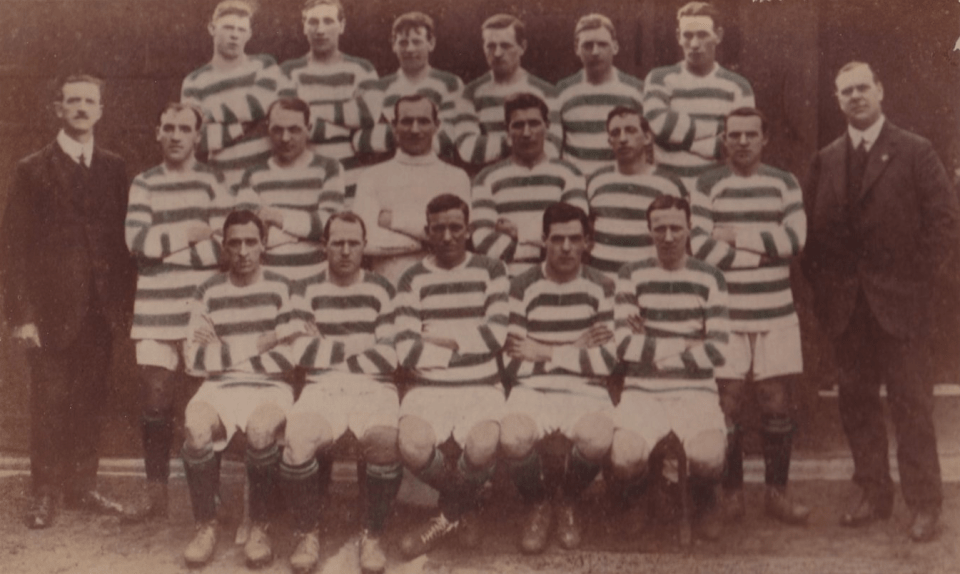
For more fascinating, funny and flabberghasting stories from Celtic’s illustrious history, buy a copy of THE SHAMROCK here: https://the-shamrock.net/magazine/

